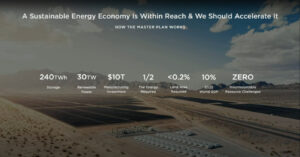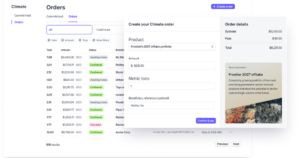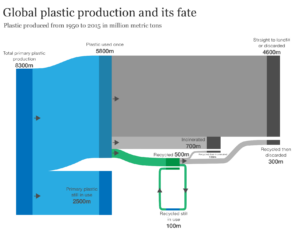
Joe Hanson’s general interest YouTube channel Be Smart has 4.97 million subscribers. Interspersed with other science content, he routinely garners hundreds of thousands of views of his videos dispelling myths about climate change.
Environmentalist and creator Leah Thomas talks up climate justice to her 256,000 instagram followers. Sometimes she is paid by consumer brands: A post sponsored by Brooks Running is about exercising in nature; one with Tommy Hilfiger suggests wrapping gifts in repurposed shopping bags.
There are millions of creators online. They appeal to consumers from Gen Z digital natives — many of whom rely on TikTok for information — as well as older audiences, whose platforms tend to be different (Youtube, Facebook) but who are nonetheless influenceable. It’s impossible to quantify the exact number of online creators who address climate change or sustainability topics in one way or another, but it’s a burgeoning space — with potential.
"This is the single most effective marketing tool that's ever been created," says Jaya Adapa, senior vice president of media and content at Futerra, a creative agency and sustainability consultancy. "If you think about spending $1 on any form of marketing, whether it be television, ads, radio or social media, direct marketing with influencers is the highest ROI, lowest investment way to communicate a message."
There is emerging hope that social media creators can play a part bringing about the mass behavior change necessary to decarbonize our economy — or, at the very least, raise awareness of what to do and how (such as shop for products that are sustainable). When creators land sponsorship deals, it becomes an entrepreneurial endeavor too.
"Creators are keen to get involved," says Lucy Shea, Futerra’s CEO.
Unilever research indicates that 75 percent of people are likely to take up behaviors to help save the planet after watching social media content about sustainability, and that 83 percent believe TikTok and Instagram are good places to get advice about how to live sustainably. It sites a recent IPCC report that estimated that "behavior and sociocultural" changes could rapidly save 5 percent of all demand-side carbon emissions.
EcoTok Collective is a collective of 18 environmental educators and activists who use social media as a platform for good. A separate coalition of sustainability-minded YouTubers numbers about 100.
Shea told me Unilever, climate-focused non-profit Project Drawdown and others are working on a digital resource to directly brief influencers who opt into a creator council about key sustainability topics, so they’re better equipped to communicate new (and sometimes complicated) topics accurately.
The possible ROI may be high, but engaging an influencer still costs money — and carries risk. "Brand safety is always going to be a concern, but I think that risk is overplayed a little bit," says Adapa. "Part of the reason that the creator connects so well with the audience is because they're not always so brand-safe, right? If you have a very sanitized voice, you’re likely not going to spark behavior change, or inspiration, or all the creative things that [creators] do."
Does your company work with social media influencers to communicate your sustainability messages? Should it?
Shea, Thomas and entrepreneur creator Zahra Biabani will be talking about the potential (and the pitfalls) at our upcoming sustainability conference GreenBiz 24 in Phoenix on Feb. 12.
In the meantime, here are three quick tried-and-true sustainability influencer pointers:
Get to the point
"Creators have a very short amount of time to communicate a complex idea. They don't use a lot of jargon and they speak in a language that a mass group of people can understand," Adapa says. "They can get some very complicated things broken down in a two- or three-minute video that would take most professors a semester to teach, and that's very powerful."
Speak to your audience
"Creators are obsessed with their audience and how their audience responds," says Shea. Influencers keep audiences coming back not by focusing exclusively on crafting or perfecting their own images, but by bringing their social media followers content that is consistently relevant to those followers’ interests. In contrast, traditional marketing may focus on refining a brand image.
Be totally honest
Futerra research indicates that "84 percent of Gen Z globally think brands aren’t honest enough about how their factory workers are treated, and 79 percent think they’re not honest enough when it comes to their environmentally impacts (compared to, respectively, 69 percent and 66 percent of millennials)." Even if you’re transparent in your official reporting, these consumers are unmoved only by metrics that track sustainability performance. An antidote? Tell real stories about your progress that will feel, to the consumer, more vivid and more honest — or get an influencer to do it for you.
- SEO Powered Content & PR Distribution. Get Amplified Today.
- PlatoData.Network Vertical Generative Ai. Empower Yourself. Access Here.
- PlatoAiStream. Web3 Intelligence. Knowledge Amplified. Access Here.
- PlatoESG. Carbon, CleanTech, Energy, Environment, Solar, Waste Management. Access Here.
- PlatoHealth. Biotech and Clinical Trials Intelligence. Access Here.
- Source: https://www.greenbiz.com/article/3-effective-ways-social-media-influencers-communicate-about-sustainability
- :has
- :is
- :not
- $UP
- 000
- 100
- 12
- 24
- 66
- 75
- 84
- 97
- a
- About
- accurately
- activists
- address
- Ads
- advice
- After
- agency
- All
- always
- amount
- an
- and
- Another
- Antidote
- any
- appeal
- ARE
- AS
- At
- audience
- audiences
- awareness
- back
- bags
- BE
- because
- becomes
- been
- behavior
- believe
- Better
- Bit
- brand
- brands
- Bringing
- Broken
- burgeoning
- but
- by
- CAN
- Can Get
- carbon
- carbon emissions
- ceo
- change
- Changes
- Channel
- Climate
- Climate change
- coalition
- Collective
- comes
- coming
- communicate
- company
- compared
- complex
- complicated
- Concern
- Conference
- connects
- consistently
- consultancy
- consumer
- Consumers
- content
- contrast
- Costs
- could
- Council
- created
- Creative
- creator
- creators
- Deals
- decarbonize
- different
- digital
- direct
- directly
- do
- don
- down
- economy
- educators
- Effective
- emerging
- Emissions
- endeavor
- engaging
- enough
- Entrepreneur
- entrepreneurial
- environmental
- environmentally
- equipped
- estimated
- Ether (ETH)
- Even
- EVER
- exclusively
- factory
- Feb
- feel
- Focus
- focusing
- followers
- For
- form
- from
- Gen
- Gen Z
- General
- get
- gifts
- Globally
- going
- good
- Group
- Hanson’s
- Have
- he
- help
- her
- here
- High
- highest
- his
- honest
- hope
- How
- How To
- HTTPS
- Hundreds
- i
- idea
- if
- image
- images
- Impacts
- impossible
- in
- indicates
- influencer
- influencers
- information
- Inspiration
- interest
- interests
- into
- investment
- involved
- IT
- jargon
- jpg
- Justice
- Keen
- Keep
- Key
- Land
- language
- least
- likely
- little
- live
- Lot
- lowest
- many
- Marketing
- Mass
- May..
- me
- meantime
- Media
- message
- messages
- Metrics
- Millennials
- million
- millions
- money
- more
- most
- Nature
- necessary
- New
- non-profit
- number
- numbers
- of
- official
- older
- on
- ONE
- online
- only
- or
- Other
- Others
- our
- own
- paid
- part
- People
- percent
- perfecting
- performance
- phoenix
- Places
- planet
- platform
- Platforms
- plato
- Plato Data Intelligence
- PlatoData
- Play
- possible
- Post
- potential
- powerful
- president
- Products
- Progress
- project
- Quick
- Radio
- raise
- rapidly
- RE
- real
- reason
- refining
- relevant
- rely
- Reporting
- resource
- respectively
- right
- Risk
- ROI
- routinely
- s
- Safety
- Save
- says
- Science
- senior
- separate
- she
- Shop
- Shopping
- Short
- should
- single
- Sites
- So
- Social
- social media
- social media influencers
- some
- sometimes
- Space
- Spark
- speak
- Spending
- Sponsored
- sponsorship
- Still
- Stories
- subscribers
- such
- Suggests
- Sustainability
- sustainable
- sustainably
- T
- Take
- talking
- Talks
- television
- tell
- tend
- that
- The
- their
- These
- they
- things
- think
- this
- those
- thousands
- three
- tiktok
- time
- to
- told
- too
- tool
- Topics
- TOTALLY
- track
- traditional
- transparent
- treated
- understand
- unilever
- upcoming
- use
- very
- vice
- Vice President
- Video
- Videos
- views
- Voice
- watching
- Way..
- ways
- WELL
- What
- when
- whether
- WHO
- whom
- whose
- will
- with
- Work
- workers
- working
- would
- you
- Your
- youtube
- youtubers
- zephyrnet










